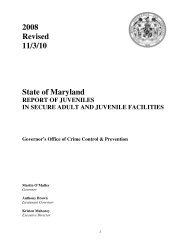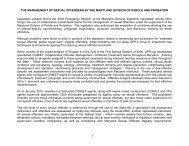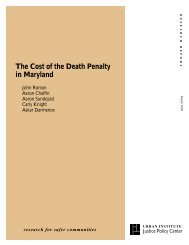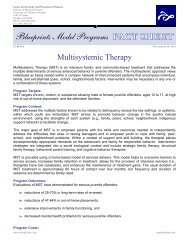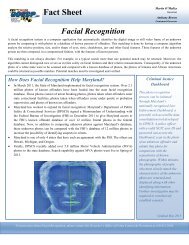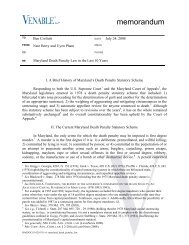Targeted Outreach - Governor's Office of Crime Control & Prevention ...
Targeted Outreach - Governor's Office of Crime Control & Prevention ...
Targeted Outreach - Governor's Office of Crime Control & Prevention ...
You also want an ePaper? Increase the reach of your titles
YUMPU automatically turns print PDFs into web optimized ePapers that Google loves.
22 <strong>Targeted</strong> <strong>Outreach</strong><br />
Target youth reported that they felt safe at the Clubs.<br />
On a scale <strong>of</strong> 1 to 10 (where 10 is the most safe and 1<br />
is the least safe), 86 percent <strong>of</strong> prevention youth<br />
rated Club safety at 8 or higher. On average, they<br />
rated the Club safety at 9.1. Intervention youth felt<br />
slightly less safe at the Club: 70 percent rated Club<br />
safety at 8 or higher, with an average rating <strong>of</strong> 8.4.<br />
Both prevention and intervention youth rated the<br />
Club safer than their school. On a scale <strong>of</strong> 1 to 10,<br />
prevention youth rated the school 7.9 and the Club<br />
9.1, on average. Intervention youth rated school<br />
7.2 and the Club 8.4. One youth we interviewed<br />
went to a particularly unsafe school. He told us<br />
that he feels safe at the Club but not at school:<br />
“I’ve seen people with weapons [in school], and<br />
my cousin got shot in school.”<br />
Are there Systematic Differences<br />
Between the Level <strong>of</strong> Youth’s<br />
Involvement at the Clubs and Their<br />
Backgrounds or Club Experiences?<br />
Although we noted that many youth (68% to 74%)<br />
reported participating one year after recruitment,<br />
the remaining youth did not. What factors contributed<br />
to youth’s ongoing participation? To answer<br />
this question, we looked at the association between<br />
youth’s background characteristics (such as risk level<br />
upon entry to the Club, as well as their age, gender<br />
and ethnicity) and their involvement in the Club. We<br />
also examined how referral sources related to participation<br />
and whether the youth’s Club experiences<br />
related to their level <strong>of</strong> involvement.<br />
Youth Characteristics<br />
Importantly, we found no significant differences in<br />
youth’s race, gender or age as an indicator <strong>of</strong> their<br />
participation in either prevention or intervention<br />
Clubs. Gang risk factors, school grades and the number<br />
<strong>of</strong> socially supportive adults at baseline also did<br />
not relate to how <strong>of</strong>ten youth attend. Frequently, programs<br />
for high-risk youth cannot keep the youth who<br />
display the most at-risk characteristics. This is not<br />
true <strong>of</strong> the GPTTO and GITTO initiatives. Youth’s<br />
gang-risk score was not related to participation. The<br />
Clubs that implemented these initiatives are not losing<br />
the kids who most need the support and diversion.<br />
Similarly, information obtained from the staff’s<br />
monthly tracking forms revealed that the rate at<br />
which youth terminate from the program is the same<br />
regardless <strong>of</strong> the youth’s gender and age.<br />
Referral Source<br />
Although Clubs cannot choose the ethnicity or age<br />
<strong>of</strong> youth who are at risk <strong>of</strong> gang involvement, they do<br />
have some control over how the youth come into the<br />
Club. Therefore, one question that seemed particularly<br />
relevant to Club implementation <strong>of</strong> GPTTO and<br />
GITTO is how the referral source related to youth’s<br />
participation at the Club.<br />
Using information from tracking forms, we examined<br />
whether the youth referred by different agencies<br />
(e.g., probation, schools, parents, direct<br />
outreach) were systematically different in retention<br />
rates, but found no evidence to this effect for either<br />
prevention or intervention youth. Dropping out <strong>of</strong><br />
the program was not related to the particular referral<br />
source. The Club and Intervention project staff’s special<br />
attention to the individual youth and efforts at<br />
tracking the youth’s progress inside the Clubs—making<br />
sure they get hooked in to programs <strong>of</strong> interest<br />
to them and that meet their needs—are likely strong<br />
contributors to this finding (we discuss these aspects<br />
more fully in Chapter V).<br />
Positive Supports<br />
Positive supports have a strong relationship to participation<br />
for prevention youth. A sense <strong>of</strong> belonging,<br />
socially supportive adults at the Club, participation in<br />
challenging and interesting activities, adults who<br />
know the youth well, and Club safety all are related to<br />
prevention youth’s participation. <strong>Prevention</strong> youth<br />
who feel a sense <strong>of</strong> belonging at the Club (r=.28,<br />
p.0001) and report that the adults at the Club are<br />
supportive (r=.16, p05), that the activities are interesting<br />
(r=.23, p001), that the Club is safe (r=.22, p001),<br />
and that adults at the Club knew them well (r=.12,<br />
p.10) have more frequent participation than do those<br />
who do not receive these supports at the Club.<br />
For intervention youth, however, perception <strong>of</strong> the<br />
program and its staff are not a factor in explaining<br />
their program participation. Intervention youth are<br />
equally likely to participate, regardless <strong>of</strong> whether<br />
they feel a sense <strong>of</strong> belonging to the program, find<br />
its activities interesting, feel the adults are supportive,<br />
feel that the Club is safe or that project staff<br />
know them well. 11 In fact, we were unable to detect







